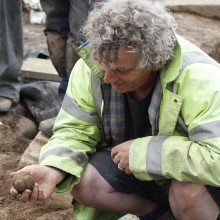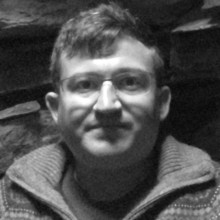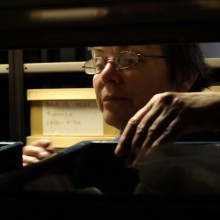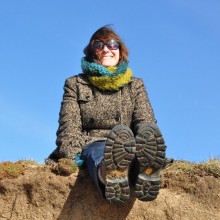
About the Project
The icons on the home page allow you to explore several paths. You can search for different types of artefact and for information on the techniques involved in their making. You can also find out about raw materials and chronology; how rocks mattered, how technological traditions changed over time and how local ways of doing things were set in relation to broader trends. And since most artefacts were recovered during excavations, you can search by selecting the name of individual sites. You can also search via the ‘biographies’ thread, which documents the entangled stories of individual artefacts, the people who collected them and the households and institutions through which different things have passed. There is also a gallery of in excess of 1100 images of flint and stone tools from Orkney; further images and 3d models of artefacts and sites are embedded throughout the site.
The site does not include every artefact ever found in Orkney. Some material is lost and a few assemblages were otherwise unavailable for study. It is also, inevitably, weighted towards the Neolithic, a consequence of the long history of interest in the monuments and stone built structures of the period. However, it brings together artefacts from many sites and from museum collections across the country, providing the first major synthesis on prehistoric stone tools from the region.
Crucial to this synthesis has been a parallel concern with the histories of collections and with the afterlives of artefacts. Important for what they say about how collections were formed, and how the discipline has changed, these longer biographies are as important as the details of how a tool was made and used in prehistory. Indeed, issues of identity and memory, of circulation and display, are often as valuable for understanding the recent circumstances of artefacts as they are for studies of the Mesolithic or the Bronze Age.
Not all of the objects on this site began their lives in Orkney. Some arrived with prehistoric people as they moved, others came through trade and exchange. And some arrived only recently, from Australia, New Zealand, North America and Continental Europe, their presence a legacy of the global connections made by Orcadians over the years. These more recent travellers are no less a part of the story.
You can pursue your interests at varying levels of detail. You can browse different types of artefacts, using photographs and 3D models to get a sense of what things look like. You can also take things further, exploring the history of different collections or the intellectual conditions in which early studies were undertaken. Our main threads will also lead you to longer articles about different aspects of the material, a comprehensive bibliography and a glossary that you may find useful. Whatever else you make of it, we hope you get as much from using the site as we have from putting it together.
The Project Team
 Professor Mark Edmonds was the Principal Investigator for the Working Stone, Making Communities Project. He holds the second Anniversary Chair of Archaeology at the University of York and has been researching stone tools since the invention of calipers. Much of his work explores the intersections between archaeology and the visual and performing arts and he has been involved in several projects that have culminated in experimental texts, exhibitions and performance pieces. He is the author of numerous books on prehistory, most recently STONEWORK, a collaboration with Rose Ferraby, and THE BEAUTY THINGS, with Alan Garner. He can be contacted at mark.edmonds [at] york.ac.uk.
Professor Mark Edmonds was the Principal Investigator for the Working Stone, Making Communities Project. He holds the second Anniversary Chair of Archaeology at the University of York and has been researching stone tools since the invention of calipers. Much of his work explores the intersections between archaeology and the visual and performing arts and he has been involved in several projects that have culminated in experimental texts, exhibitions and performance pieces. He is the author of numerous books on prehistory, most recently STONEWORK, a collaboration with Rose Ferraby, and THE BEAUTY THINGS, with Alan Garner. He can be contacted at mark.edmonds [at] york.ac.uk.
 Dr Hugo Anderson-Whymark is a flint and stone tools specialist with experience of Late Upper Palaeolithic to Iron Age and post medieval gun flint assemblages from across the British Isles. He also has an interest in 3d modelling and examples of his work can be seen throughout this site and on Sketchfab. Hugo is now Curator of Prehistory (Palaeolithic to Neolithic) at National Museums Scotland, Edinburgh. He can be contacted at h.anderson-whymark [at] nms.ac.uk.
Dr Hugo Anderson-Whymark is a flint and stone tools specialist with experience of Late Upper Palaeolithic to Iron Age and post medieval gun flint assemblages from across the British Isles. He also has an interest in 3d modelling and examples of his work can be seen throughout this site and on Sketchfab. Hugo is now Curator of Prehistory (Palaeolithic to Neolithic) at National Museums Scotland, Edinburgh. He can be contacted at h.anderson-whymark [at] nms.ac.uk.
 Ann Clarke is a freelance lithics specialist who works on coarse stone tools and flaked lithics from sites across the UK and Ireland. Her current projects include the large assemblage of medieval rotary querns and other stone tools from Cromarty and the Mesolithic exploitation of rhyolite in the Cairngorms. You can see her wide range of projects and interests at her website www.annrocks.co.uk and contact her directly at annclarke [at] btconnect.com.
Ann Clarke is a freelance lithics specialist who works on coarse stone tools and flaked lithics from sites across the UK and Ireland. Her current projects include the large assemblage of medieval rotary querns and other stone tools from Cromarty and the Mesolithic exploitation of rhyolite in the Cairngorms. You can see her wide range of projects and interests at her website www.annrocks.co.uk and contact her directly at annclarke [at] btconnect.com.
 Dr Antonia Thomas is an archaeologist, illustrator and Lecturer in Archaeology at the Archaeology Institute, University of the Highlands and Islands, Kirkwall. Over the last 15 years, she has worked on a number of prehistoric sites in Orkney, including at the Braes of Ha’Breck where she has directed fieldwork and post-excavation since 2006. Her PhD (Art and Architecture in Neolithic Orkney: University of Aberdeen/UHI 2015) comprised a detailed contextual study of carved stonework at Skara Brae, Maeshowe and the Ness of Brodgar. Her wider research explores archaeologies of art and visual culture. For more details see https://uhi.academia.edu/AntoniaThomas
Dr Antonia Thomas is an archaeologist, illustrator and Lecturer in Archaeology at the Archaeology Institute, University of the Highlands and Islands, Kirkwall. Over the last 15 years, she has worked on a number of prehistoric sites in Orkney, including at the Braes of Ha’Breck where she has directed fieldwork and post-excavation since 2006. Her PhD (Art and Architecture in Neolithic Orkney: University of Aberdeen/UHI 2015) comprised a detailed contextual study of carved stonework at Skara Brae, Maeshowe and the Ness of Brodgar. Her wider research explores archaeologies of art and visual culture. For more details see https://uhi.academia.edu/AntoniaThomas
Acknowledgements
This website has been put together by Prof Mark Edmonds, Dr Hugo Anderson-Whymark, Ann Clarke and Dr Antonia Thomas, Department of Archaeology, University of York. Pat Gibbs of Heritage Technology played a crucial role in helping with the design and implementation of the site and we could not have done it without him. The work was funded by The Leverhulme Trust (under the title Working Stone, Making Communities: Technology and Identity in Prehistoric Orkney) and we would like to acknowledge the support of staff at the Trust during the lifetime of the project. Crucial support in administering the project was provided at the University of York by Jo Tozer, Shirley Foster and Claire Mcnamara.
Many individuals and institutions have helped to make things happen. At National Museums Scotland: Alison Sheridan, Trevor Cowie, Margaret Wilson, Helen Osmani and Hugh Wallace. At Archaeology Institute, University of Highlands and Islands/Orkney Research Centre for Archaeology (ORCA): Nick Card, Jane Downes, Colin Richards, Paul Sharman, Dan Lee, Ingrid Mainland, Martin Carruthers, Anne Mitchell, Sean Page and Julie Gibson. At The Orkney Museum: Janette Park, Sheila Garson, Gail Drinkall, Peter Drummond and Tom Muir. At the Hunterian Museum: Malcolm Chapman and his collections team, Graham Nisbet, John Faithfull and Sally-Anne Couper. At University of Aberdeen Museums, Neil Curtis and Louise Wilkie. At Glasgow Museums: Jane Flint. At Stromness Museum: Janette Park, Kathleen Ireland and Jen Harland. At BEVARS: Mick Miles and Diana Coles. At Skaill House: Malcolm Macrae. At Carrick House: Rosemary Joy. At Tomb of the Eagles: Kathleen MacLeod. At Aberdeenshire Museums Service: Helen Chavez. At The Museum of Archaeology and Anthropology, Cambridge: Imogen Gunn. At Dunrobin Castle: Scott Clark. At The British Museum: Gill Varndell.
We would also like to acknowledge the support of all at Orkney Archaeology Society, the Skara Brae Visitor Centre and the Orkney Library and Archive, and are very grateful for help of various kinds from Chris Gee, Annette Lott, Wendy Frost, John Flett Brown, Hayley Green, Jen Harland, Michael Sharpe, Henry Irvine-Fortescue, Woody Musgrove, Richard Chatterton, Caroline Wickham-Jones, Neil Leask, Martha Johnson, David Clarke, Chris Stewart-Moffitt and Ben Chan. Last but by no means least, we extend our thanks to all those people in Orkney who opened their doors to us, allowing us to record cherished artefacts and to hear their stories. The project is all the richer for their gifts.